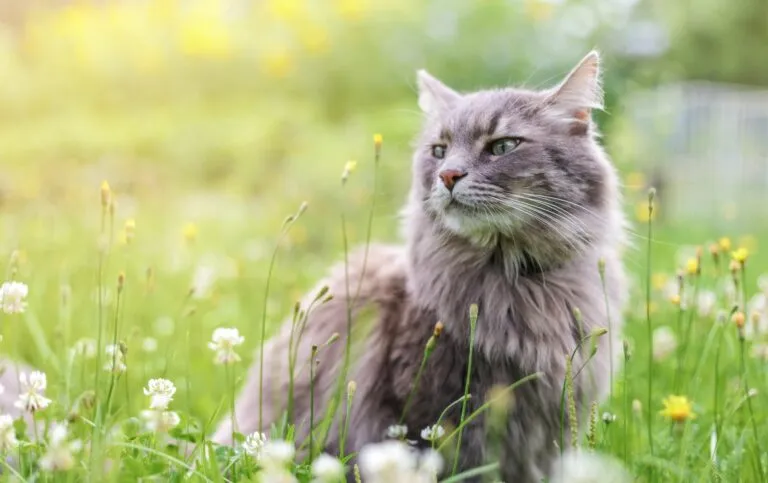It's not uncommon for cats to suffer from what is known as feline bronchial asthma, an allergic inflammation of the bronchi (bronchitis). All age groups and cat breeds can suffer from this disease, although Siamese cats are affected particularly often.
Due to the narrowing of the respiratory tract, sick cats stand out in particular due to a dry cough and poor performance. Since there is also the threat of anaphylactic shocks, the allergic disease should definitely not be underestimated.
How does asthma come about with cats?
Like with us humans, allergies can emerge spontaneously at any time with cats too. House dust mites, pollen or even perfumed cat litter can often cause an acute type allergy (type 1) in the context of feline asthma:
In the course of initial contact with allergens (e.g. pollen), the immune system releases neurotransmitters on a massive scale, which leads to the formation of specific antibodies (protective proteins). These exposed antibodies then dock to certain immune cells (basophilic granulocytes and mast cells) and thereby become cell-mediated antibodies. If the cat comes into contact with pollen once again after this apparent sensitisation, a firm bond between the cell-mediated antibodies and allergens is formed within a few seconds and minutes. The consequence is a massive release of inflammatory mediators like histamines, prostaglandins and leukotrienes, which are normally found in small bubbles (vessels) within the basophilic granulocytes and mast cells. The inflammatory mediators then cause a narrowing of the bronchi that is typical of asthma:
- A concentration of the muscles in the wall of the bronchi
- Formation of inflammatory fluid and thick mucous
- Strong growth of the muscle and epithelial cells of the bronchial structures
- Deposits of connective tissue (fibrosis)
How can feline bronchial asthma be recognised?
Feline bronchial asthma emerges within a few seconds to minutes. However, the frequency with which a cat shows allergic symptoms depends on the frequency of contact with the antigen. If this is located in the cat’s immediate vicinity, the asthma will be chronic to acute. Affected cats show symptoms such as:
- Dry cough and possible shortness of breath (breathing through the mouth) and the mucous membranes turning blue
- Increased weakness and reluctance to exercise
- Redness, swelling and possible formation of wheals on the skin and mucous membranes
- Increased itching
- Depending on the extent of the allergic reaction, asthma can trigger a fatal anaphylactic shock
How is asthma diagnosed in cats?
If there are signs of your cat suffering from an allergic reaction, it’s advisable to see a vet. This should be done straight away particularly with severe allergic reactions in which the cat experiences shortness of breath and breathes through its mouth. The vet can make a significant improvement to a life-threatening situation in minutes by administering oxygen and medication to expand the bronchi.
Diagnosing feline bronchial asthma takes place after the owner interview (anamnesis) and the general clinical examination with a thorough examination of the respiratory tract:
Abdominal and in severe cases mouth respiration can often be observed externally during the adspection. Checking the mucous membrane (e.g. in the mouth) also helps with diagnosis, because a blue colour is a sign of a lack of oxygen. A blood test can then be carried out to determine the eosinophilic granulocyte content. If these immune cells increase in the blood, this can be a sign of an allergy or a parasite infestation. The latter can then be ruled out in a faecal examination. An X-ray also helps with a structural assessment of the lungs and the surrounding tissue.
A cytological examination can still be carried out with stable patients by means of a bronchoalveolar lavage, i.e. washing the lungs. Here too, an increase in eosinophilic granulocytes can be a sign of asthma in cats. Unfortunately detection of the antigen that causes this is often difficult, therefore feline asthma is commonly not found. It is therefore helpful to remove allergens like perfumed cat litter or cigarette smoke from the cat’s immediate vicinity. If the situation improves, it can be assumed that this is the triggering allergen.
How can asthma be treated?
Treatment of asthma in cats is given as acute emergency therapy or treatment of chronic cat asthma:
- Emergency treatment: acute and severe allergic reactions require quick measures like giving oxygen and medication to expand the bronchi. Since this is a life-threatening situation, cats then have to stay under veterinary observation.
- Chronic feline asthma: immunosuppressives like prednisolone in the form of tablets or inhalers can be administered following discussion with your vet to suppress the immune system and avoid overreactions. Allergens should also be removed from the household as much as possible.
What is the prognosis?
The prognosis of asthma in cats cannot be generalised. There are many cats that only show mild allergic symptoms throughout their life, whilst some cats tend to suffer from anaphylactic shocks. The latter can prove fatal if not recognised and treated at an early stage. However, the prognosis improves significantly with regular adherence to the correct medication and removing allergens from the cat’s environment.
Can asthma be prevented in cats?
Allergies emerge spontaneously and can’t always be avoided. However, if the owner already knows what antigen their cat shows an allergic reaction to, they can remove this from the cat’s environment as far as possible. It is also advised to avoid smoking around cats, to use unperfumed cat litter and to regularly dust the household.
